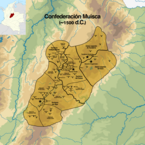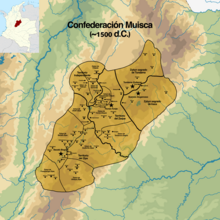Quemuenchatocha
| Quemuenchatocha | |
|---|---|
| hoa | |
 Quemuenchatocha, ruler of Hunza | |
| Reign | 1490–1537 |
| Predecessor | Michuá |
| Successor | Quiminza |
| Born | 1472 Hunza, Muisca Confederation |
| Died | 1538 (aged 65–66) Ramiriquí, New Kingdom of Granada |
| Issue | Quimuinza (nephew) |
| Chibcha | Quimuinchateca |
| Dynasty | Hunza |
Quemuenchatocha or Quimuinchateca (named in the earliest sources Eucaneme) (Hunza, 1472–Ramiriquí, 1538) was the second-last hoa of Hunza, currently known as Tunja, as of 1490. He was the ruler of the northern Muisca when the Spanish conquistadores arrived in the Muisca highlands. His contemporary enemy psihipquas of the southern Muisca were successively Nemequene and Bogotá.
Biography
Eucaneme was eighteen years old when he accessed the throne, succeeding his predecessor Michuá as ruler of the northern Muisca. His reign was cruel and under his tyranny the Muisca feared him. His rule was so brutal that when the Spanish conquerors entered the outskirts of the capital Hunza and found a hill with poles where bodies were dangling, they named it Cerro de la Horca ("Gallows Hill").[1]
Both his predecessor Michuá and their eternal enemies, the southern Muisca led by psihipqua Saguamanchica died in the Battle of Chocontá in 1490. Eucaneme succeeded the throne for the northern Muisca based in Hunza while Nemequene accessed for the southern Muisca, ruled from Muyquytá. To halt the northern expansion politics of their southern enemies, Quemuenchatocha sought the help of the caciques of Gámeza, Sugamuxi, Tundama and Sáchica. In 1514 to prevent blood loss Eucaneme proposed to fight only man-to-man battles. This idea didn't work out and the southern zipa Nemequene, while having won the battle of the Arroyo de las Vueltas, was fatally hurt. The southern troops retreated and installed the new ruler Tisquesusa. The iraca, Sugamuxi, negotiated a truce between the northern and southern factions of the Muisca which held until the arrival of the Spanish in 1537.[2]
Upon the advancement of the Spanish instead of fighting them, he tried to please them with gifts while hiding the rich treasures of the Muisca, famous for their trade in emeralds and vast quantities of gold. He forbade his people to show the upcoming Spanish conquerors the way to his fortress and installed harsh penalties for doing so.[3]
The strategy didn't work out. On August 20, 1537, the Spanish conquerors led by Gonzalo Jiménez de Quesada found Eucaneme sitting on this throne decorated with gold, emeralds and precious cloths and he was taken prisoner and deported to Suesca. This happened where today the Convento de San Agustín is located. Eucaneme fled to the village of Ramiriquí where he shortly afterwards died. Following the Muisca rules of heritance, his nephew Quiminza succeeded to the throne as last ruler of Muisca before the New Granada viceroyalty of Spain in northern South America was established.[1]
While not named as Quemuenchatocha, the defeat of the hoa of Hunza is described in the work of uncertain authorship about the conquest; Epítome de la conquista del Nuevo Reino de Granada.[4]
In Tunja, capital of the Boyacá department, a statue honouring Quemuenchatocha and his successor Aquiminzaque (Monumento a la Raza Indígena) has been erected.[5]
Quemuenchatocha in Muisca history
| History of the Muisca | |||||||||
| <timeline>
Preset = TimeHorizontal_AutoPlaceBars_UnitYear ImageSize = width:1250 barincrement:25 PlotArea = left:20 right:20 bottom:20 top:0 Define $bold = fontsize:M shift:(7,-1) Colors = id:canvas value:rgb(0.97,0.97,0.97) id:grid2 value:gray(0.88) id:lithic value:gray(0.8) id:ceramic value:rgb(0.95,0.9,0.6) id:mummy value:rgb(0.81,0.87,0.9) id:bochica value:rgb(0.9,0.7,0.8) id:art value:rgb(0.3,1,0) id:economy value:rgb(0.2,0.8,0.1) id:agriculture value:rgb(0.5,1,0) id:green value:rgb(0.5,1,0) id:muisca value:rgb(1,0.84,0) id:white value:gray(1) id:colonial value:gray(0) id:empire value:rgb(0.95,0.7,0) id:years value:gray(0.5) BackgroundColors = canvas:canvas Period = from:800 till:1570 ScaleMajor = unit:year increment:50 start:800 ScaleMinor = unit:year increment:10 start:1450 gridcolor:grid2 AlignBars = justify BarData= barset:culture barset:muisca barset:spanish barset:rulers barset:events bar:period PlotData =
width:15 fontsize:M textcolor:black align:left anchor:from shift:(3,-5) barset:culture from:800 till:1570 fontsize:L color:ceramic text:" Myths" align:left width:112 barset:muisca from:800 till:1540 fontsize:L color:muisca text:"Muisca Confederation" anchor:middle width:50 barset:spanish from:1539 till:1570 color:empire text:" Spanish Empire" align:left width:30 barset:rulers from:1448 till:1458 fontsize:L color:bochica text:"Tundama " align:left width:10 from:1520 till:1539 fontsize:M color:bochica text:"Tundama " align:left width:25 from:1448 till:1457 fontsize:L color:mummy text:"Suamox " align:left width:10 from:1435 till:1450 fontsize:M color:ceramic text:"Idacansás " align:left width:28 from:1500 till:1520 fontsize:M color:mummy text:"Nompanim " align:left width:10 from:1520 till:1537 fontsize:M color:mummy text:"Sugamuxi " align:left width:25 from:1438 till:1447 fontsize:M color:ceramic text:"El Dorado " align:left width:10 from:1420 till:1427 fontsize:M color:ceramic text:"Tota Monster " align:left width:10 from:1432 till:1437 fontsize:M color:ceramic text:"Goranchacha " align:left width:10 from:1510 till:1530 fontsize:M color:ceramic text:"Pacanchique " align:left width:10 from:1427 till:1437 fontsize:M color:ceramic text:"Thomagata " align:left width:10 from:1437 till:1447 fontsize:M color:ceramic text:"Tutazúa " align:left width:10 from:1448 till:1455 fontsize:L color:lithic text:"Hunza " align:left width:10 from:1450 till:1470 fontsize:M color:lithic text:"Hunzahúa " align:left width:10 from:1470 till:1490 fontsize:M color:lithic text:"Michuá " align:left width:15 from:1490 till:1537 fontsize:M color:lithic text:"Quemuenchatocha " align:left width:20 from:1537 till:1539 fontsize:M color:lithic text:" Aquiminzaque" align:left width:15 from:1420 till:1450 fontsize:L color:ceramic text:" Gods" align:left width:540 from:1536 till:1539 fontsize:L color:black text:" Conquest" align:left width:510 from:1420 till:1447 fontsize:S color:ceramic text:"Chiminigagua" align:left width:10 from:1422 till:1447 fontsize:M color:ceramic text:"Sué" align:left width:30 from:1424 till:1447 fontsize:M color:ceramic text:"Chía" align:left width:30 from:1426 till:1447 fontsize:M color:ceramic text:"Bochica" align:left width:10 from:1428 till:1437 fontsize:S color:ceramic text:"Chibchacum" align:left width:10 from:1430 till:1447 fontsize:S color:ceramic text:"Cuchavira" align:left width:10 from:1432 till:1447 fontsize:S color:ceramic text:"Chaquén" align:left width:10 from:1434 till:1447 fontsize:S color:ceramic text:"Huitaca" align:left width:10 from:1436 till:1447 fontsize:S color:ceramic text:"Nencatacoa" align:left width:10 from:1448 till:1455 fontsize:L color:green text:"Bacatá " align:left width:10 from:1450 till:1470 fontsize:M color:green text:"Meicuchuca " align:left width:10 from:1470 till:1490 fontsize:M color:green text:"Saguamanchica " align:left width:15 from:1490 till:1514 fontsize:M color:green text:"Nemequene " align:left width:15 from:1514 till:1537 fontsize:M color:green text:"Tisquesusa " align:left width:20 from:1537 till:1538 fontsize:M color:green text:" Sagipa" align:left width:15 barset:events from:1469 till:1470 fontsize:M color:colonial text:" Battle of Pasca" align:left width:10 from:1489 till:1490 fontsize:M color:colonial text:" Battle of Chocontá" align:left width:10 from:1537 till:1538 fontsize:M color:colonial text:" Battle of Tocarema" align:left width:10 from:1420 till:1450 fontsize:L color:ceramic text:" People" align:left width:330 from:1438 till:1440 fontsize:S color:ceramic text:"Lache " align:left width:10 from:1444 till:1447 fontsize:S color:ceramic text:"U'wa " align:left width:10 from:1431 till:1437 fontsize:S color:ceramic text:"Guane " align:left width:10 from:1423 till:1437 fontsize:S color:ceramic text:"Muzo " align:left width:10 from:1442 till:1447 fontsize:S color:ceramic text:"Achagua " align:left width:10 from:1430 till:1437 fontsize:L color:ceramic text:"Muisca " align:left width:10 from:1422 till:1437 fontsize:S color:ceramic text:"Panche " align:left width:10 from:1440 till:1447 fontsize:S color:ceramic text:"Tegua " align:left width:10 from:1433 till:1439 fontsize:S color:ceramic text:"Guayupe " align:left width:10 from:1425 till:1437 fontsize:S color:ceramic text:"Sutagao " align:left width:10 </timeline> | |||||||||
 Altiplano |
 Muisca |
 Art |
 Architecture |
 Astronomy |
 Cuisine |
 El Dorado |
 Subsistence |
 Women |
 Conquest |
See also
Lua error in mw.title.lua at line 346: bad argument #2 to 'title.new' (unrecognized namespace name 'Portal').
References
- ^ 1.0 1.1 (in Spanish) Biography of Quemuenchatocha - Pueblos Originarios
- ^ (in Spanish) Muisca history - Banco de la República
- ^ (in Spanish) Zaque Quemuenchatocha - Universidad Distrital Francisco José de Caldas
- ^ Epítome, p.88
- ^ (in Spanish) Statue honouring Quemuenchatocha
Bibliography
- "Epítome de la conquista del Nuevo Reino de Granada", Boletín Cultural y Bibliográfico, 16 (3), Banco de la República: 81–97, 1979 [1889 (1539)], retrieved 2016-11-24
External links
- (in Spanish) Animated video about Quemuenchatocha
- Pages with script errors
- Articles with Spanish-language sources (es)
- Short description with empty Wikidata description
- Articles without Wikidata item
- Muisca rulers
- 1472 births
- 1538 deaths
- 15th-century South American people
- 16th-century South American people
- Indigenous warriors of the Americas
- People from Tunja
